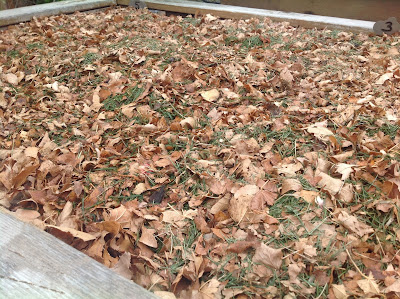 |
| Dry, cracked, unhappy, not tucked in soil |
 |
| Use mowed leaves with grass for your bedding |
The steps are simple, first pull out all remaining spent vegetables and annual plantings. Toss any disease-free materials into the compost pile. Next, the free "bedding" is all around you–fallen leaves with or without mowed grass (pesticide free a must). This mix makes the best comforter or maybe you're a duvet person. I like lots of blankets, so make your mulch bed three to four inches thick to begin.
Place the shredded leaves over the bed, then water it well so it doesn't blow away in the first ten minutes. Renew the mulch all winter with leftover leaves you'll keep bagged outside somewhere (plan ahead and ask neighbors for their leaves for reserve). Weed and seed free straw is an option too. Avoid wood mulch, especially for vegetable beds; it just doesn't break down easily like leaves and grass. Use wood mulch around perennials, shrubs and trees. In lieu of covering beds with organic material, growing cover crops adds valuable organic matter and protects the soil all winter too, I'll write about them in the next post.
 | |||||
| Soil underneath will be protected all winter and much easier to work in next spring |
 | |||||||
"Go on...time to get out there and make your winter beds!"










0 komentar: